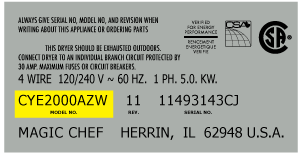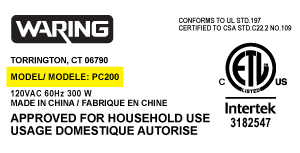RTW4516FW2 Whirlpool Washer - Instructions
Keep searches simple. Use keywords, e.g. "leaking", "pump", "broken" or "fit".
top half of agitater not working properly
Removed softner dispenser, removed bolt on top of agitater,replaced parts supplied with repair kit.
Directions were inclosed in package that were easy to follow.I ordered Thrust spacer not knowing it was included in repair kit.
I WAS VERY PLEASED WITH YOUR WEB SITE AND DELIVERY TIME.
Directions were inclosed in package that were easy to follow.I ordered Thrust spacer not knowing it was included in repair kit.
I WAS VERY PLEASED WITH YOUR WEB SITE AND DELIVERY TIME.
Parts Used:
-
Philip from Flat Rock, NC
-
Difficulty Level:Easy
-
Total Repair Time:15 - 30 mins
28 of 29 people
found this instruction helpful.
Was this instruction helpful to you?
Thank you for voting!
Agitatorwouldn't agitate on the washing machine
before ordering the parts, I pulled the cap of the agitator, removed some internal parts of the agitator - had to remove one hex head bolt, and noticed the threads on the 3 little teenie weenie plastic dogs were worn off. I bought the repair kit on line after entering the model number, parts were here in a few days, and the repair took about 15 minutes. Works like new again.
The directions provided with the parts were very clear and made the job quick, easy, and painless.
The directions provided with the parts were very clear and made the job quick, easy, and painless.
Parts Used:
-
Kelly from Newport News, VA
-
Difficulty Level:Easy
-
Total Repair Time:15 - 30 mins
-
Tools:Socket set
26 of 28 people
found this instruction helpful.
Was this instruction helpful to you?
Thank you for voting!
Agitator loose spinning
Three of the four agitator cogs had broken. The agitator was able to spin freely both clockwise encounter clockwise which it should not be doing. I replaced the cogs as well as a couple additional parts just to be sure but the cogs were the important one. Very easy.
Parts Used:
-
Matthew from AUSTIN, TX
-
Difficulty Level:Easy
-
Total Repair Time:30 - 60 mins
-
Tools:Socket set
24 of 25 people
found this instruction helpful.
Was this instruction helpful to you?
Thank you for voting!
Scratches in Surface
This product comes in a bottle with a brush like Liquid Paper. It goes on incredibly easy. A second coat might be needed. I wanted to prevent rust from setting in so I covered the scratches and dings. The paint is a little brighter since my washer is 10 years old but it still looks great.
Parts Used:
-
Michelle from Richardson, TX
-
Difficulty Level:Really Easy
-
Total Repair Time:Less than 15 mins
75 of 181 people
found this instruction helpful.
Was this instruction helpful to you?
Thank you for voting!
latch switch was not working
unfasten top from back, slide top forward and lift up, remove switch and cable (one piece), in stall new switch and cable, put top down and slide back, reinstall screws.
Parts Used:
-
John from BEAVER DAMS, NY
-
Difficulty Level:Really Easy
-
Total Repair Time:30 - 60 mins
-
Tools:Nutdriver, Screw drivers
28 of 41 people
found this instruction helpful.
Was this instruction helpful to you?
Thank you for voting!
Shaking violently during spin cycle
Replaced the 4 suspension rods/springs. Only disconnect and replace one at a time. The tub will fall out if you disconnect and replace more than one rod/spring at a time.
Parts Used:
-
Harold from MELROSE, FL
-
Difficulty Level:Easy
-
Total Repair Time:1- 2 hours
24 of 29 people
found this instruction helpful.
Was this instruction helpful to you?
Thank you for voting!
Cog stripped causing agitator to not turn
Removed top cap on agitator w/ flathead screwdriver. Removed protective cap over bolt and cog housing shaft. Used 7/16 deep socket w/ extension to remove bolt. Removed housing where stripped cogs were located. Cogs seated loosely in shaft housing no tools required to remove cogs. Replaced cogs in housing, made sure everything was lined correctly. re-inserted housing into shaft. ,screwed bolt, replaced caps and works like new.
Parts Used:
-
Vicki from Houston, TX
-
Difficulty Level:Easy
-
Total Repair Time:Less than 15 mins
-
Tools:Screw drivers, Wrench set
22 of 25 people
found this instruction helpful.
Was this instruction helpful to you?
Thank you for voting!
agitator making noise and didn't want to turn
I unsnapped the top of the mechanism and removed the agitor assembly, (I had already put together the new one,) I just had to unsrew the old one to get it out and screw in the new one. This took me less than 10 minutes from start to finish. My husband was away for the week and this was left up to me if I wanted it done. So I (a female) decided that I would attempt it.
A Piece of Cake. thanks to Parts Select, I have a few more years with this machine. I was really hating to purchase a new machine. So for less than $25.00 with no service call "I Fixed It!"
A Piece of Cake. thanks to Parts Select, I have a few more years with this machine. I was really hating to purchase a new machine. So for less than $25.00 with no service call "I Fixed It!"
Parts Used:
-
Jo Anne from Crossville, TN
-
Difficulty Level:Really Easy
-
Total Repair Time:Less than 15 mins
-
Tools:Socket set
21 of 22 people
found this instruction helpful.
Was this instruction helpful to you?
Thank you for voting!
Agitator directional cogs worn out
Removed bolt holding top of agitator, removed top of agitator. Replaced parts. Reinstalled agitator. An old machine now works like a new model.
Parts Used:
-
Do n from LAWTON, OK
-
Difficulty Level:Really Easy
-
Total Repair Time:15 - 30 mins
-
Tools:Socket set
22 of 26 people
found this instruction helpful.
Was this instruction helpful to you?
Thank you for voting!
Agitator was not working properly due to broken plastic pieces in agitator
First I removed the top of the agitator and then used a socket and ratchet to unscrew the bolt and put the new one on and tightened up the bolt, real easy.
Parts Used:
-
doug from spokane, WA
-
Difficulty Level:Easy
-
Total Repair Time:15 - 30 mins
-
Tools:Nutdriver, Socket set
22 of 27 people
found this instruction helpful.
Was this instruction helpful to you?
Thank you for voting!
washer not agitating
This was a learning experience but it appears to have worked out in the end. Our 3 1/2 year old washer was not agitating much and I attributed that to a loose bolt. I would tighten the bolt and it would work ok for a load or two and then stop agitating. I would find that the bolt was loose again. I took a number of steps to try to get the bolt to stay on tight - threadlock, a new bolt, more threadlock, and applying progressively more force on the bolt, with no better results. Yet the repair guys on you tube were saying the bolt only needs to be snug, not super tight - something was amiss. I even went so far as to secure the basket with a rope so I could use two hands on the socket wrench (please don't do this). But when I tried the washer again there was no agitation at all! I observed the agitation output in manual test mode and the bolt was turning in lock step with the shaft but the agitator wasn't turning at all. That's when I suspected that the problem was actually a worn lower agitator. Trouble was that now I couldn't seem to get the bolt off. Turning the wrench caused the shaft itself to rotate so I couldn't loosen the bolt from the shaft. I thought I broke the washer. Then I considered that maybe the shaft was rotating because the washer was in an agitation mode when I turned it off. I went back into manual test mode, made the washer spin, then turned it off. Fortunately, this worked. The shaft was again stationary and, albeit with great difficulty, I got the bolt off.
I removed the agitator, and as a pro would have figured out long before, the ridges inside the top of the lower agitator were almost completely worn down. I realized then that the contact between these ridges and the splines on the shaft is what is supposed to cause the lower agitator to move with the shaft. The purpose of the bolt is just to keep the agitator in the correct position and from coming off the shaft. I had been trying to compensate for the worn agitator ridges by over-tightening the bolt, creating some contact at the top of the shaft. This would work for a little while, then the agitator would start slipping, and the slipping agitator was acting just like a wrench loosening the bolt (until my stupid rope trick, that is.)
So I ordered a new agitator (only the lower agitator was bad, but the price of an entire agitator isn't a lot more than just the lower part and I was reading that the upper agitator parts will wear over time) and another new bolt (because my repeated attempts to over-tighten the first one I ordered had split the rubber gasket apart and worn the bolt head).
The new agitator fit snugly on the splines of the shaft so I sensed no need to use excessive force on the bolt. Just an easy one-handed snug tightening with the socket wrench, using the other hand to hold the lower agitator. The washer is now working again.
I removed the agitator, and as a pro would have figured out long before, the ridges inside the top of the lower agitator were almost completely worn down. I realized then that the contact between these ridges and the splines on the shaft is what is supposed to cause the lower agitator to move with the shaft. The purpose of the bolt is just to keep the agitator in the correct position and from coming off the shaft. I had been trying to compensate for the worn agitator ridges by over-tightening the bolt, creating some contact at the top of the shaft. This would work for a little while, then the agitator would start slipping, and the slipping agitator was acting just like a wrench loosening the bolt (until my stupid rope trick, that is.)
So I ordered a new agitator (only the lower agitator was bad, but the price of an entire agitator isn't a lot more than just the lower part and I was reading that the upper agitator parts will wear over time) and another new bolt (because my repeated attempts to over-tighten the first one I ordered had split the rubber gasket apart and worn the bolt head).
The new agitator fit snugly on the splines of the shaft so I sensed no need to use excessive force on the bolt. Just an easy one-handed snug tightening with the socket wrench, using the other hand to hold the lower agitator. The washer is now working again.
Parts Used:
-
David from EAST AMHERST, NY
-
Difficulty Level:Easy
-
Total Repair Time:15 - 30 mins
-
Tools:Socket set
17 of 17 people
found this instruction helpful.
Was this instruction helpful to you?
Thank you for voting!
Top Half of Agitator would not function without appying sideways pressure
Heard about the website... 1 minute to find it, 10 minutes to order new cogs... 3 day wait for new parts... Rec'd Fedex, 15 minutes total to pull the agitator cover (bleach dispenser) then the bung cover with o-ring (just lift out) expose bolt, unskrew and remove top portion of agitator or entire agitator if it's easier. Seperate, remove black cog holder (slides up the spindle) and replace cogs one at a time just like the old ones. Reassemble in reverse and you are back in business. Saved the $75 deductible on my home appliance warrenty. You guys are the best... cheers...
Parts Used:
-
Donald from Fredericksburg, VA
-
Difficulty Level:Really Easy
-
Total Repair Time:15 - 30 mins
-
Tools:Socket set
18 of 21 people
found this instruction helpful.
Was this instruction helpful to you?
Thank you for voting!
Agitator did not rotate properly
1. Removed the softener dispenser
2. Removed the cap covering the clutch dogs and the bolt holding it all in place.
3. Removed the bolt holding the two agitator pieces and the clutch dogs together.
4. Removed the two agitator parts.
5. Replaced the clutch dogs.
6. Reassembled and put the bolt back in place.
7. Replaced the gasket on the cover that goes over the clutch and bolt.
8. Replaced the softener dispenser
Very easy!
2. Removed the cap covering the clutch dogs and the bolt holding it all in place.
3. Removed the bolt holding the two agitator pieces and the clutch dogs together.
4. Removed the two agitator parts.
5. Replaced the clutch dogs.
6. Reassembled and put the bolt back in place.
7. Replaced the gasket on the cover that goes over the clutch and bolt.
8. Replaced the softener dispenser
Very easy!
Parts Used:
-
Tenel from The Woodlands, TX
-
Difficulty Level:Easy
-
Total Repair Time:30 - 60 mins
-
Tools:Pliers, Socket set
18 of 21 people
found this instruction helpful.
Was this instruction helpful to you?
Thank you for voting!
Agitator was barely agitating. Making a clicking noise.
Removed agitator cap. Removed bolt inside with socket wrench. Located plastic cogs Pulled out old cogs and slid in new cogs and put back together and works great. Easy to take apart and put back together. Very cheap repair. Cogs less that $4.00 plus shipping. Shipped next working day.
Parts Used:
-
Charmaine from Slidell, LA
-
Difficulty Level:Easy
-
Total Repair Time:15 - 30 mins
-
Tools:Socket set
17 of 18 people
found this instruction helpful.
Was this instruction helpful to you?
Thank you for voting!
Top section of agitator not turning
Found directional gogs broken. Searched washer model # on PS.com and easily found schematic drawing. Received parts in a couple of days. Removed agitator with one nut, and other parts just pulled apart. Replaced the cogs and other parts which were not really broken....just worn. Everything went back together easily, and I was done! Parts Select saved me a LOT of time, and especially money, than if I had called a repair co. THANKS!
Parts Used:
-
John from Stone Mountain, GA
-
Difficulty Level:Really Easy
-
Total Repair Time:15 - 30 mins
-
Tools:Socket set
17 of 19 people
found this instruction helpful.
Was this instruction helpful to you?
Thank you for voting!


































